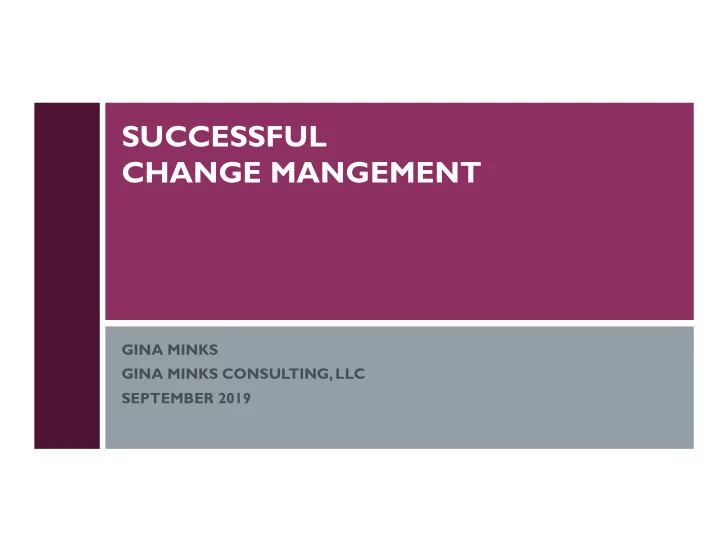

SUCCESSFUL CHANGE MANGEMENT GINA MINKS GINA MINKS CONSULTING, LLC SEPTEMBER 2019
THIS WEBINAR WILL COVER: Creating a How change can Ideas for identifying communication plan impact your projects project stakeholders for stakeholders and why it’s so important The decision-making The advantages of What constitutes an process for using workflows to effective workflow implementing aid change for changes change management
RISK MANAGEMENT VS CHANGE MANAGEMENT RISK CHANGE Identified and mitigated during the project planning Unexpected and often not addressed in the original process project processes High probability risks are addressed before the Relies on specific techniques for successful project begins implementation of change Risk Change Management is ALWAYS Risk Management BUT Risk Management is NOT ALWAYS Change Change Management
WHY CHANGE?
DRIVING FORCES OF CHANGE: Crisis Organizational Structure T echnology Business Processes Internal / External Pressure Opportunities Planned Abandonment Just Because….
HOW CHANGE IMPACTS PROJECTS
HOW CHANGE CAN AFFECT A PROJECT Budget Scope Schedule Staff Quality of Work Support Credibility
SUCCESS OR FAILURE? IT DEPENDS… Nature of the change Consequences of the change Organizational history of change Individual personality types Individual experiences with change
CHANGE MANAGEMENT -- SUCCESS The software technician is hit by a bus. A new tech is hired and can quickly come up to speed on duties because of detailed project documentation and current status reports. An unexpected software upgrade is scheduled so any delays won’t immediately affect student, faculty or staff work. A “special edition” e-newsletter is sent to the public keeps everyone informed of project delays due to weather issues. Explicit instructions are sent to staff about how to change their passwords after a security breach.
CHANGE MANAGEMENT -- FAILURE Institution changes from Office 365 to G-Suite without confirming all the business processes work with G-Suite tools. Content Management system is implemented without confirming it works with legacy data. Failing to communicate an extreme delay in implementation leads administration to believe project is a failure and budget is allocated elsewhere. A new tracking system for email and work projects is implemented without staff input or training opportunities.
THREE C’S OF CHANGE MANAGEMENT COMMUNICATION COORDINATION CONTINUITY
THREE C’S OF CHANGE MANAGEMENT COMMUNICATION COORDINATION CONTINUITY WITH STAKEHOLDERS OF TASKS OF OPERATION
FINDING THE RIGHT CHANGE AGENT
QUALITIES OF A CHANGE AGENT Clear vision Patient yet persistent Asks tough questions Knowledgeable and leads by example Strong relationships built on trust
DESIGNATING A CHANGE AGENT Cuturally Sensitive Entrepreneurial Inclusiveness Innovative Different Awareness of Others Resilient Skills than the Project Socially Responsible Active Learner Manager Self-awareness Stakeholder Focus Flexible thinking Commitment to results Developing others plpnetwork.com
THE CHANGE AGENT SHOULD: Build personal capital Pick their battles Fully understand and research the problem Take the proper approach Propose solutions, NOT problems Handle objections properly Remains positive Allow leaders to take credit Be willing to compromise Keep trying
COMMUNICATION WITH STAKEHOLDERS
IDENTIFYING STAKEHOLDERS - CPIG C ustomers P roviders (Internal or External) I nfluencers (Internal or External) G overnance REMEMBER: Forgetting a stakeholder can be detrimental to the project/change Review stakeholders throughout the project Con sider creating a stakeholder profile
How Do Stakeholders Deal with Change? Reaction = Shock/Denial Communicate Reaction = Frustration/Depression Listen to Concerns & Offer Support Reaction = Willing to Experiment Allow time to explore & test Reaction = Accept Change Celebrate the Commitment
COMMUNICATION PREFERENCES Channel Message Email Status Update Phone In-depth Face-to-Face Overview Physical report Administrative information Meeting Public-centered
IMPLEMENTING CHANGE
SUCCESSFUL CHANGE = CONSISTENT AND TRANSPARENT What information is needed to make a change? Who can request a change? What is the process for evaluating the change? Who can approve a change? What is the process for communicating the change to stakeholders? How is the successful change communicated? How is the change process evaluated?
WORKFLOWS FOR SUCCESSFUL CHANGE
DEVELOP A CHANGE MANAGEMENT WORKFLOW Identification of issue needing change Change request Communication Evaluation of change request Approval Implementation of change Documentation of change Evaluation of change process
CREATE A PROCESS THAT WORKS Identification of Issue Evaluation of Request Change Change Process Communication to Evaluate Change Stakeholders Request Documentation of Change Approval Implementation
MORE THAN HIGH LEVEL WORKFLOW Identification of issue needing change – Specific information Change request -- Documentation, impact statement, submission process Evaluation of change request – Who needs to be involved?, What is impacted? Standards?
MORE THAN HIGH LEVEL WORKFLOW Approval – Who is authorized to approve the change, dissemination, documentation Implementation of change – How is team empowered to make the change? Workflows, Schedules, Budgets, Staff Documentation of change – Who will document the change to the scope of work, project workflow, etc. Evaluation of change process – Who evaluates, method, documentation, changes to process
EVALUATING THE CHANGE PROCESS
LESSONS LEARNED What was the business impact? (Remember CoOP) What did and did not work? (BE SPECIFIC) Identify process problems Identify implementation problems Identify staff / people problems
CHANGING THE CHANGE MANAGEMENT PROCESS Identify the problem Evaluate the process Make the change Communicate the change to the change process Remember: Every organization is different with different people and different histories.
Know your stakeholders Know Understand why the change needs to happen Understand Communicate the change Communicate Implement the change Implement F ollow a workflow for implementing change Follow Evaluate the change Evaluate A REVIEW OF CHANGE MANAGEMENT
CONTACT ME: QUESTIONS?? GINA MINKS GINA@ GINAMINKSCONSULTING.COM
Recommend
More recommend